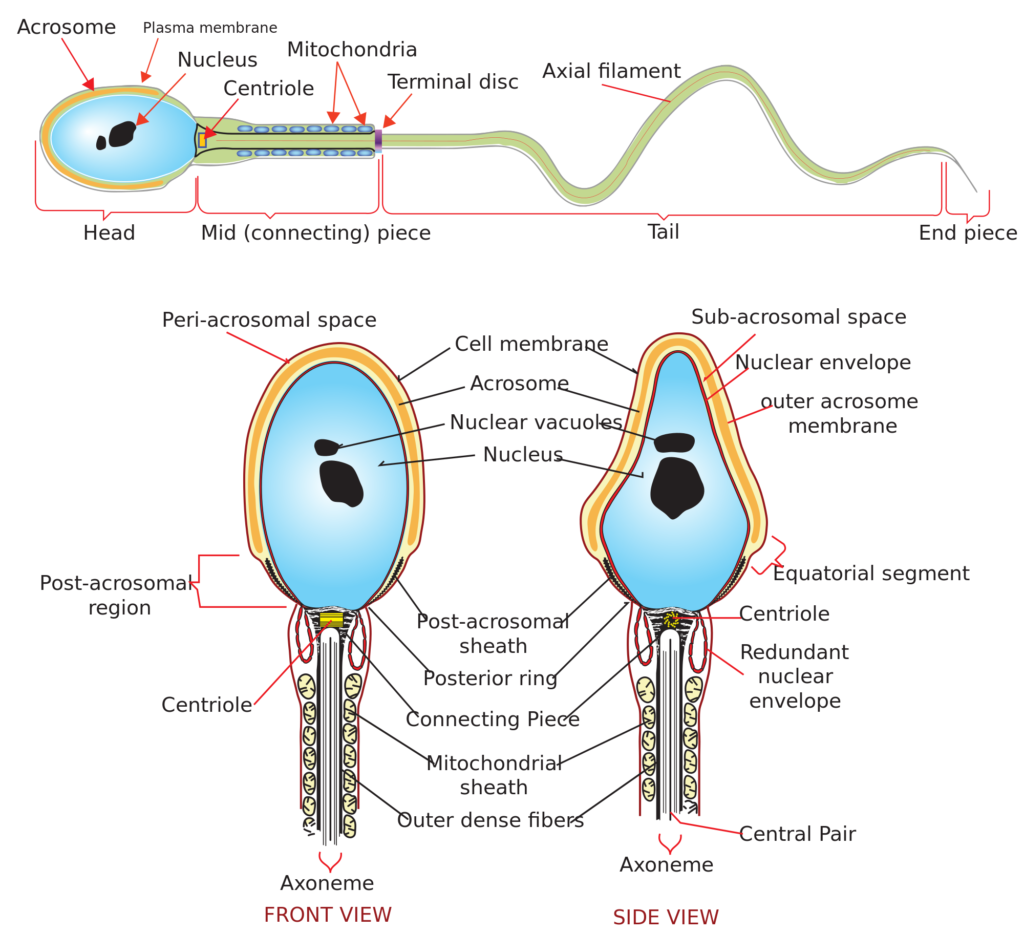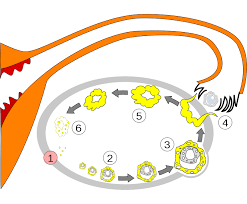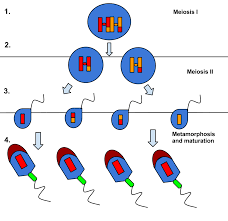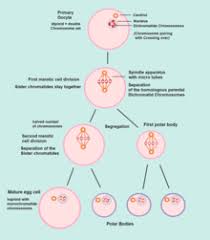gametogenesis
In testis, the immature male germ cells, spermatogonia produce sperms by a process called spermatogenesis that begins at puberty.

Spermatogenesis occurs in four stages:-
(i) Spermatocytogenesis:- In spermatocytogenesis, the spermatogonia present on the inside wall of the seminiferous tubules multiply by mitotic division and increase in numbers. Each spermatogonia is diploid containing 46 chromosomes. Some spermatogonia undergo change as they grow and increase in size by accumulating nourishing materials and are called Primary spermatocytes.These are destined to undergo meiosis whereas other remain as spermatogonia.
(ii) Meiosis-I:- A primary spermatocyte is diploid, (2n) 44 + XY (total 46) chromosomes. It completes the first meiotic division (reduction division) leading to the formation of two equal. Haploid cells called secondary spermatocytes which have only 23 chromosomes each i.e 22 + X or
22 + Y.
(iii) Meiosis-II:- The secondary spermatocytes undergo the second meiotic division to produce four equal, haploid spermatids. The number of chromosomes in each spermatid is 23
(iv) Spermiogenesis:- Transformation of spermatids into sper is termed spermiogenesis. A spermatid is non- motile and heavy. It has organelles like mitochondria, golgi bodies, centrioles, nucleus etc. During spermiogenesis, the weight of gamete is reduced along with the development of locomotory structures. Nucleus becomes compact forming the major part of head of spermatozoa. Golgi complex of spermatid gives rise to acrosome. Much of the cytoplasm of a spermatid is lost. It forms a thin layer around middle piece. After spermiogenesis the sperm heads become embedded in the Sertoli cells, and are finally released from the seminiferous tubules by the process called spermiation.
Note:- In spermatogenesis, from one primary spermatocyte four haploid sperms are formed.
Hormonal Control of Male Reproductive System:- Spermatogenesis starts at the age of puberty due to significant increase in the secretion of gonadotropin releasing hormone (GnRH) from hypothalamus. The increased levels of GnRH then acts at the anterior pituitary gland and stimulates secretion of two gonadotropins – luteinizing hormone (LH) and follicle stimulating hormone (FSH). LH acts at the leydig cells and stimulates synthesis and secretion of androgens. Androgens, in turn, stimulate the process of spermatogenesis. FSH acts on the Sertoli cells and stimulates secretion of some factors which help in the process of Spermiogenesis. Sertoli cells also secrete another proteinaceous, hormone called inhibin, which suppresses FSH synthesis. So, FSH along with testosterone stimulates sperm production in the seminiferous tubules
Structure of mature sperm:- Mature sperm cell consists of head, a neck, a middle piece and a tail. A plasma membrane envelops the whole body of sperm. The sperm head contains a very little cytoplasm, an elongated haploid nucleus, the anterior portion of which is covered by a cap-like structure, acrosome. The acrosome is filled with enzymes that help in fertlisation of ovum. These enzymes called sperm lysins dissolve the membranes enveloping the ovum and help the sperm cell to enter the ovum. The short neck, contains two distinct granules- the proximal and distal centrioles. The proximal centriole plays a crucial role during the first cleavage of the fertlised ovum. The distal centrioles gives rise to the axial filament of the long tail of the sperm. The middle piece possesses numerous mitochondria (25 to 30 arranged spirally) which produce energy for the movement of tail that facilitates sperm motility essential for fertilization, that is why it is called the power house of the sperm. The tail is made up of a central axial filament surrounded by asmall amount of cytoplasm and cell membrane as external sheath.

The human male ejaculations semen in female tract during coitus, containing a sperm count of 200 to 300 million sperms. For normal fertllity, a least 60 percent of these sperms must have normal shape and size and at least 40 percent of them must show vigorous motility. Sperms released from seminiferous tubules, are transported by the accessory ducts, secretions of epididymis, vas deferens, seminal vesicles and prostate are essential for maturation and motility of sperms. The functions of the male accessory ducts and glands are maintained by the testicular hormones (androgens).
The process of formation of a mature female gamete is called oogenesis which is markedly different from spermatogenesis. Oogenesis is intiated during the embryonic development stage when a couple of million gamete mother cells (oogonia) are formed within each ovary, no more oogania are formed of added after birth. Scattered ovarian follicles are embedded in the stroma of cortex.

An ovarian follicle consists of an oocyte, surrounded by one or more layers of follicular (flat epithelial) cells, The granulose cells, which are derived from the germinal epithelium lining the ovary. The oogonial cells start division and enter into prophase-I of the meiotic division, and get temporarily arrested at this stage called primary oocytes. Each primary oocyte gets surrounded by alayer of granulosa cells and is then called primary follicle.
A large number follicles degenerate from birth to puberty. Degeneration of ovarian follicles is called follicular atresis and their disposal is done by phagocytes. Therefore, at puberty only 60,000 to 80,000 primary follicles are left in each ovary.
With onset of puberty, a primary follicle begins to mature with each ovarian cycle. The follicular cells become cuboidal, divide by mitosis to form a stratified epithelium, The granulose layer. So, the primary follicles get surrounded by more layers of granulose cells and a new theca, called secondary follicles. Granulosa cells rest on abasement membrane and the surrounding stromal cells form theca folliculi.
The secondary follicle soon transforms into a tertiary follicle which is characterized by a fluid filled cavity antrum, Which appears between the granulosa cells, inially, the antrum is cresent shaped, but with time it gratly enlarges. The fluid of antrum is liquor folliculi. As the follicles grow, the theca folliculi become organized into inner layer of secretory cells, the theca interna and an outer of connective tissue cells containing fibroblast-like cells, the theca externa. The maturing oocytes adhere to the wall of the follicle through a pedicel/stalk, cumulus oophorus formed by granulose cells, and remains suspended in liquor folliculi. Theca interna is composed of cells having characteristics of steroid secretion, rich in blood vessels and theca externa gradually merges with ovarian stroma.
The primary oocyte within the tertiary follicle grows in size and completes its first meiotic division at puberty. It is an unequal division resulting in the formation of a large haploid secondary oocyte and a tiny first polar body. The secondary oocyte retains the bulk of nutrient rich cytoplasm of the primary oocyte. The tertiary follicle changes into the mature follicle or Graafian follicle.
The secondary oocyte forms a new membrane called Zona pellucid surrounding it. This thick coat of zona pellucida is composed of glycoproteins. Later, the granulose cells lying in close vicinity of the process called ovulation. After ovulation, the ruptured follicle left in the ovary is converted to a structure called corpus luteum, which mainly secretes progesterone.

